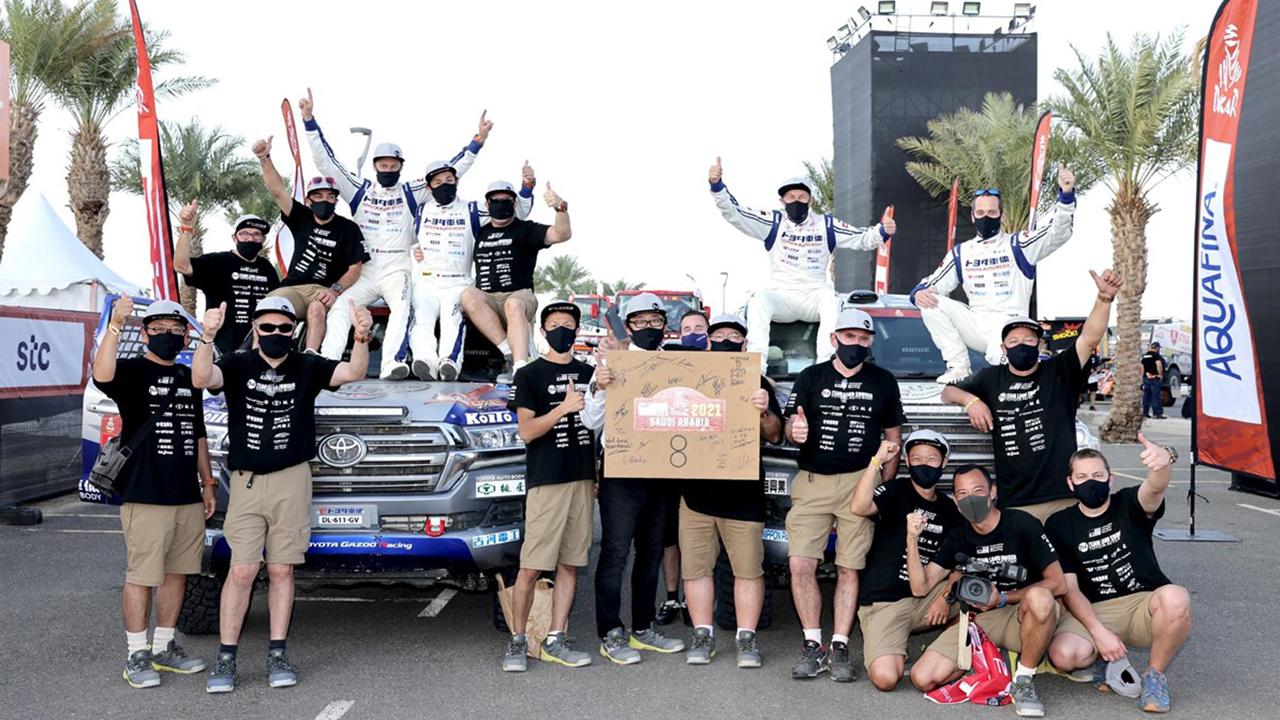
Toyota Times presents an interview conducted with rally driver Akira Miura, who won in his class in the 2021 Dakar Rally." Getting eight consecutive wins is not good enough," Miura said. Read about the challenges him and the team faced with the Land Cruiser in the rally.

In this story, Toyota Times presents an interview that the editorial team conducted with rally driver Akira Miura, who won in his class in the Dakar Rally, which is known to be the toughest motorsports event in the world.
The rally started on January 3, with competitors racing for more than 7,600 kilometers in the Saudi Arabian desert for 13 days. Miura participated in a Toyota Land Cruiser, finishing successfully with a class win. This is his second win in the rally, and as a team, it was a great achievement of eight consecutive wins.
We interviewed Miura the day after the eighth win. To honor the achievement, we started by congratulating him.
But surprisingly, Miura solemnly responded with something the editorial team didn’t expect.
"It turned out afterward that getting eight consecutive wins is not good enough,” he said.
Why is it not good enough? The answer is in the interview part of this article. Before introducing the interview content in its entirety, let’s overview what the Dakar Rally is and who Akira Miura is.
What Is the Dakar Rally and Who Is Akira Miura?
The Dakar Rally is said to be the toughest motorsports event in the world, where people join with not only vehicles but also with motorcycles.
The location of the race this year, which was held from January 3 to 15, was the desert of Saudi Arabia. It was held in a desert in South America until 2019, and in a desert in Africa before that.
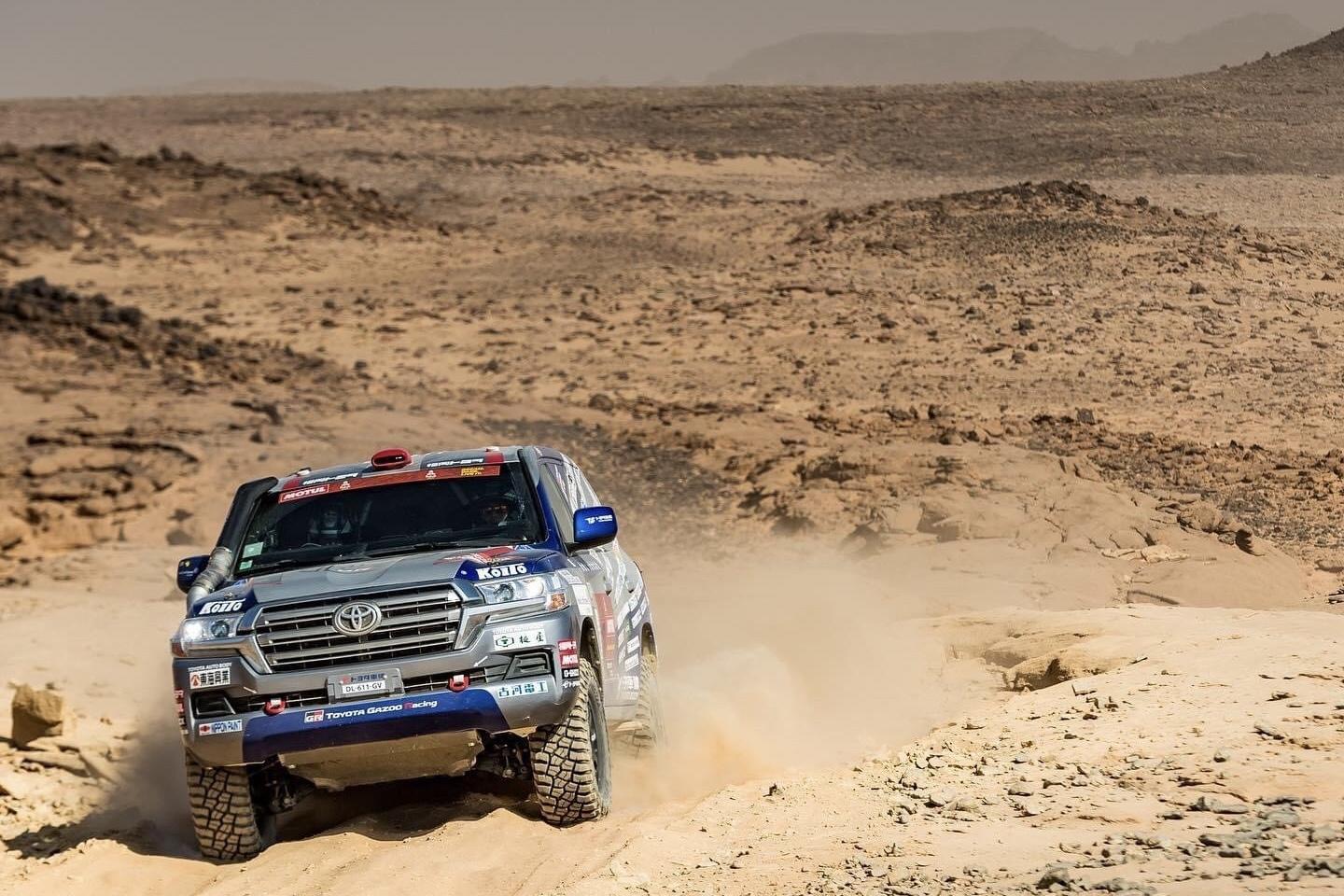
When the rally started in the 1970s, the goal was set as Dakar, the capital city of the Republic of Senegal, which is the origin of the name of the Dakar Rally.
There is a Toyota team that has participated in the tough race. The name of the team is “Team Land Cruiser Toyota Auto Body.” Miura is the driver of the team.
Toyota Auto Body is the name of a company that manufactures Toyota vehicles, including the Land Cruiser. As such, the team’s origin and mission are to challenge, with pride in their products, the world’s tough roads.
Team Land Cruiser participated with two vehicles in the production vehicle class, where production vehicles without special settings, except for equipment to protect the driver and passengers, are used in the journey. This represents the challenge of proving the quality and durability of their vehicles, in which they have pride.
One might think that even with a production model, it is still special because the person driving it is a professional driver. That’s not exactly correct. Miura is an employee of Toyota Auto Body, working in the Public Affairs Department of the company’s General Administration Division.
After joining the company, he applied to join the rally team after finding out about such an opportunity. He first served as a navigator, who supports the driver in the passenger seat, and a few years later, he applied to be a driver. This year’s rally was his sixth challenge after becoming a driver, and he was appointed an “ace driver” for the first time.
The team has won the production class title for seven consecutive years. Being named an ace driver meant that Miura had inherited the mission of “continuing to win”. Under such pressure, he successfully finished driving 7,646 kilometers (of which the rally race zones cover 4,767 kilometers), capturing the eighth class win.
As an employee driving the Land Cruiser with the responsibility to prove its reputation as well as to continue the team’s history of winning, the level of pressure he was exposed to was not something easy to deal with, but he fulfilled his responsibility.
A Surprising Response to 8 Consecutive Wins
On the day after the rally, team members including Miura underwent PCR tests in preparation for returning to Japan. We conducted an online interview after their tests.
Two mechanics (Mr. Iwaasa and Mr. Nakatake) were at the same venue with Miura, so they joined the interview. The two mechanics work for Fukuoka Toyota, which is a Toyota’s dealership in Japan. They were also in the race to prove what they represented as mechanics.
Without further ado, below is the full script of the interview with Miura.
Toyota Times:
Congratulations. Eight consecutive wins! Wow!
Miura:
Yeah, but then it seems that getting eight wins was not enough.
Yesterday, I contacted President Keiji Masui (of Toyota Auto Body) after the rally, and he said: “Please inform Morizo (President Akio Toyoda).” So, I sent him a message via SNS.
President Toyoda replied: “Only eight consecutive wins? Not 12?”
When I explained that it was Hino (Team Sugawara, which won the truck division) that got 12 consecutive wins, he said, “Because I’ve been going around saying 12 wins, let’s have 12! So, four more!” So, I ended up only being only halfway there. (Laughs.)
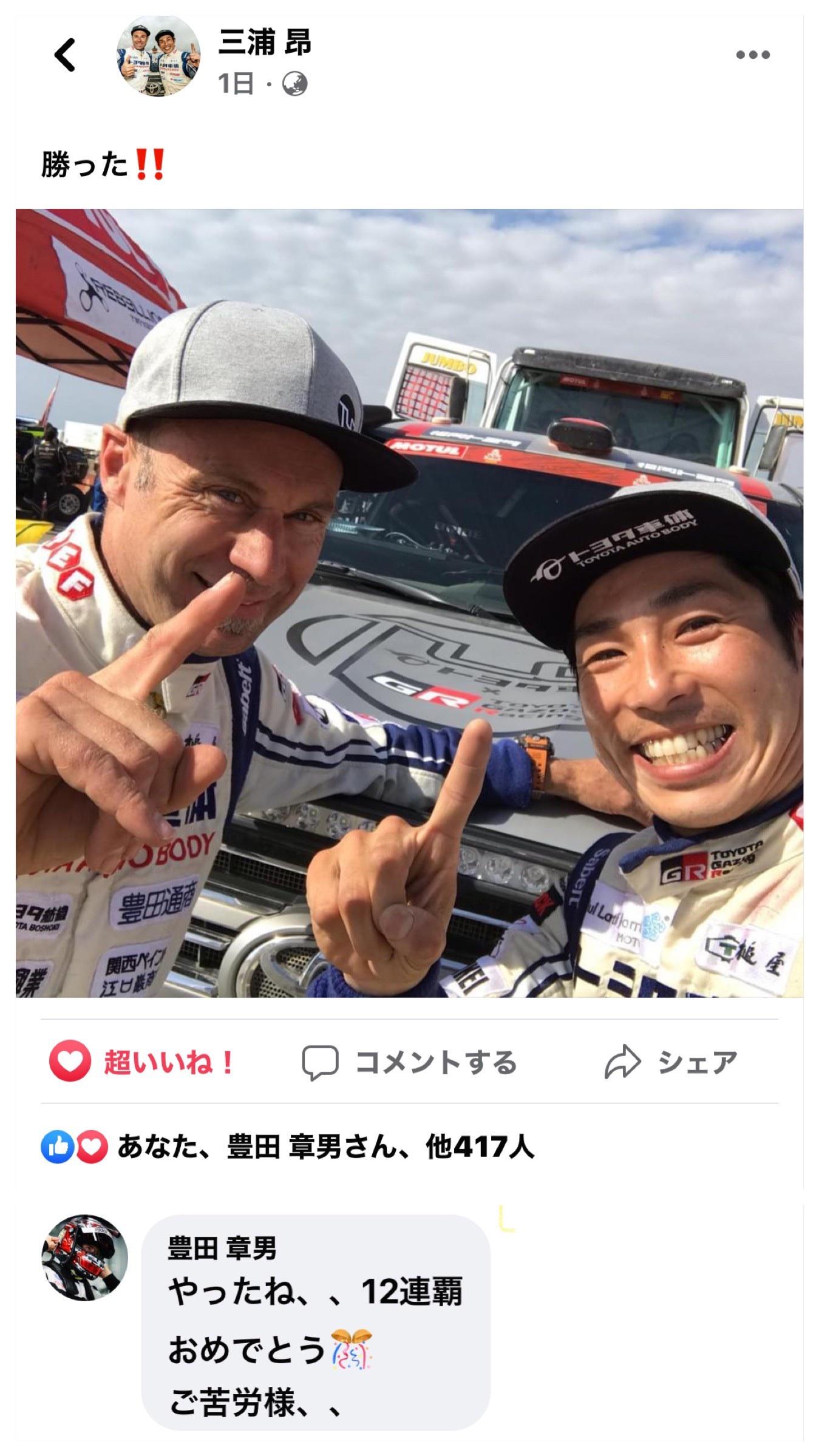
Toyota Times:
You’re still only two-thirds of the way there. (Laughs.) You have to keep driving.
Miura:
I wanted to keep going. I'm still absolutely fine.
Usually, I get really nervous. But this time, I was simply happy because I was able to start driving every day.
Usually, I approach a race thinking about how to eliminate risks, such as getting a flat, getting stuck, not to mention rolling over.
But this time, when I came across a difficult sand dune, I was filled more with excitement about what I should do to pass over it, so I was able to drive with a positive mindset. And I was able to drive with a sense that the vehicle would respond.
Thoughts as an Ace Driver
Toyota Times:
Last year, the team had seven consecutive wins. But you, yourself, finished second for the second straight time. After reaching the goal line last year, I think you said something to President Toyoda that expressed some dismay, no?
Miura:
Until last year’s rally, while firmly supporting (the ace drivers), it was my personal challenge to win. That was my dream.
But this year, I was in Vehicle No. 1 (as the ace behind the wheel), so I had strongly felt that I had to win.
So, I thought about how Christian Lavieille (who was the ace driver until last year’s rally) did it. Christian didn't take lines that were anything special or use out-of-this-world techniques.
He simply looked for where to go, drove in a way that would get him there, and always did what needed to be done, as normal.
Therefore, although I had a desire to win, when I drove while thinking about how to give 100 percent to what I had to do within my abilities, my times were stable, and it was like I was able to get a good rhythm going, mentally as well.
Toyota Times:
On the first day, you had some minor setbacks, such as a flat and your vehicle bottoming out. Didn’t those make you feel anxious?
Miura:
Not rushing in such situations played a big role. Even though I got a flat, in such cases I usually think about how to make up for lost time.
However, when you get a flat, that means that you are pushing your vehicle beyond its limits. So you have to hold back to improve your times.
While driving, I had a sense that my thoughts were somewhere else, and I also felt in sync with (navigator) Laurent Lichtleuchter. So, I think I was able to drive while feeling as one with the vehicle.
Making a Land Cruiser Come Alive
Toyota Times:
We were impressed by your comment in another interview in which you said: “I got excited every time we encountered a tough course! I could tell that Laurent was thinking along with me about how we could make our Land cruiser come alive.” What was it like to drive in a way that your Land Cruiser came alive?
Miura:
In the case of sand dunes, normally, I would think: “Where’s the best place to go over?” and “If I do it over there, will I get stuck?”
But instead, I had a concrete image of “I'm going up here and I will crossover.” And my sensors become honed and conditioned for understanding what it was that I had to do to get that done.
When actually crossing a dune, there is an instant in which the vehicle becomes strained, but I came up with ideas one after another on how to get around it.
Because the vehicle gave me a hint for what to think about, instead of looking for something, I was able to constantly find the best option in the flow of things.
It really felt good, and the impression I had was that I was able to completely dispel my sense of not feeling fully competent to take on dunes.
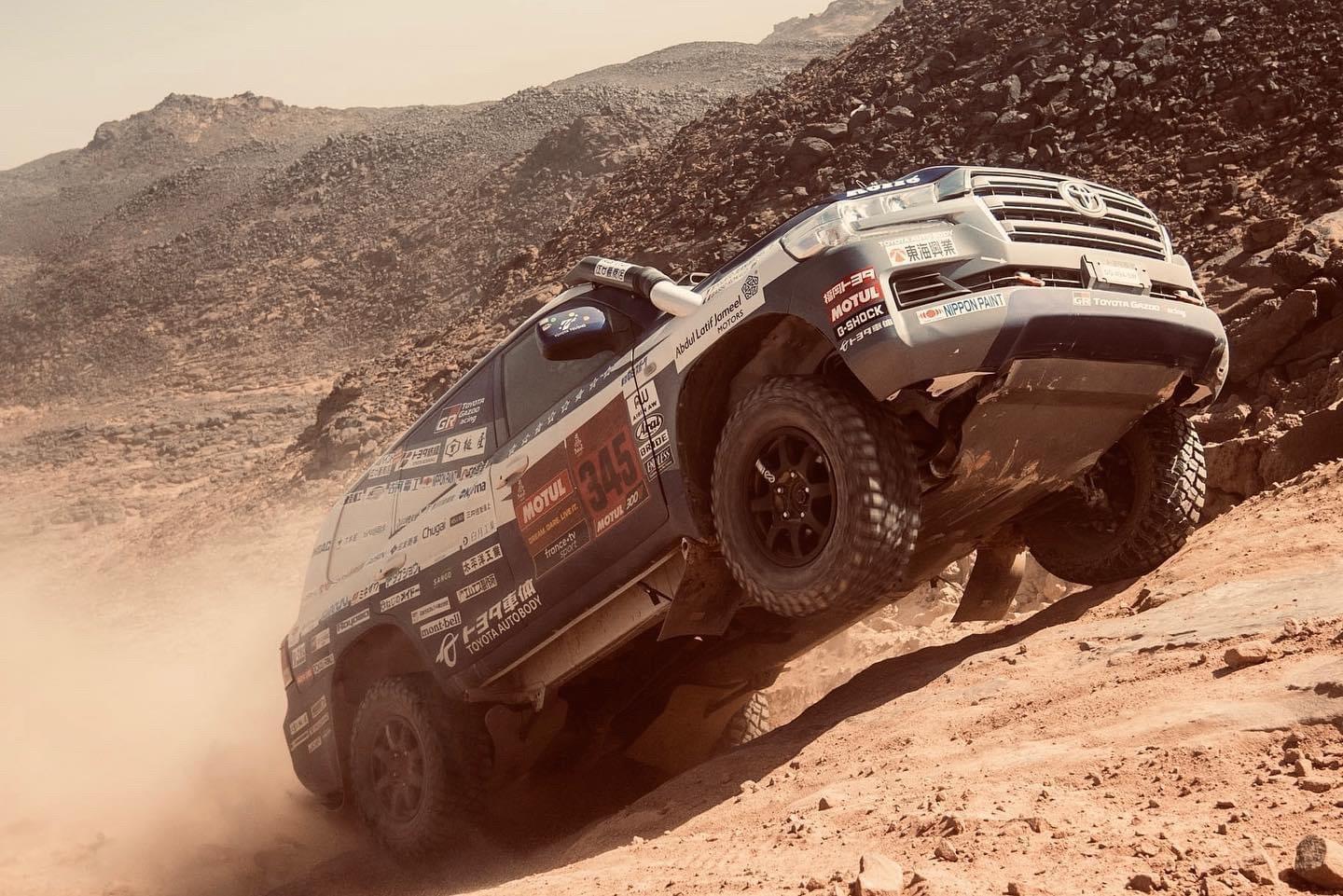
Toyota Times:
That's exactly what President Toyota says—“Converse with the road and the car.”
President Toyota attacked the dunes with you three years ago, right?
(Akio joined the vehicle test conducted by Team Land Cruiser in Morocco in October 2018)
The course this time was all dunes. Were you not adept at “conversing with dunes”?
Miura:
Well, after all, no matter how hard you try, you can’t reproduce that environment in Japan. It’s unique.
I've been trying to conquer dunes using various methods, But Christian, who drove last year, and professional drivers basically compete daily in rallies that go through dunes, so it’s very difficult to catch up while being in Japan.
For that reason, I felt that I wasn’t good at it, but this time, the more difficult the dune I encountered the more I got excited, and I looked forward to driving through the dunes every day.
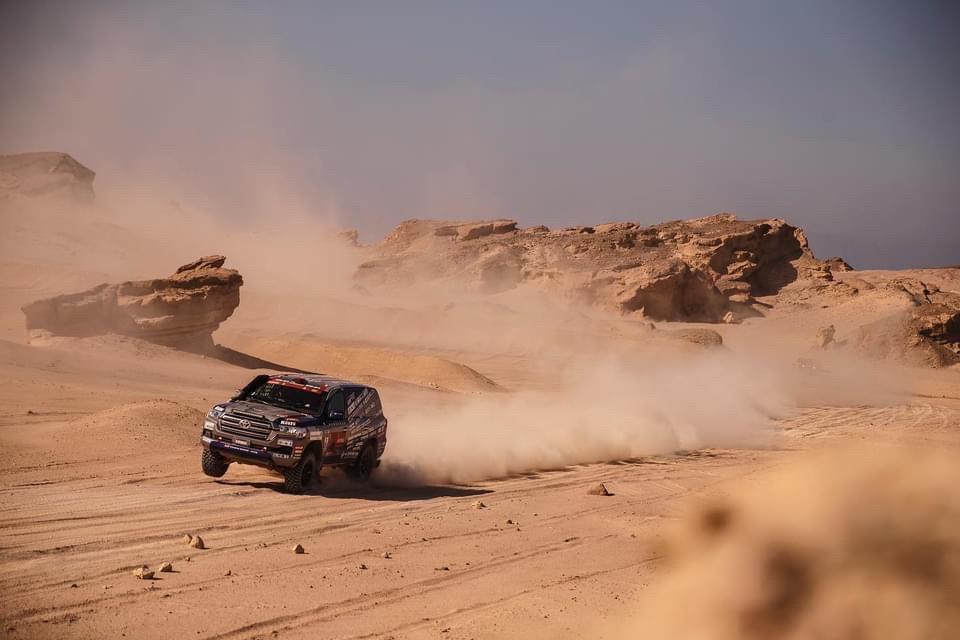
Toyota Times:
Due to the spread of COVID-19, for this season, you weren’t able to do test runs overseas, and we think there were many days during which you couldn’t drive at all. It must not have been easy for you to come together with the many foreign members of the team.
Miura:
I didn’t really have many chances to get in a vehicle, so I was just happy to have the opportunity to simply drive this time.
It was only in the Andalusian rally in Spain in October that I was able to work with foreign mechanics.
Toyota Times:
I think COVID-19 made preparations difficult. With what kind of feelings did mechanics approach the actual race?
Iwaasa:
It was the first time for everyone (on the team) to get together. Being able to go at it with everyone together gets you burning inside, and, because there were so many things that were fun and exciting, my concerns about not having been able to touch the vehicle went away and I was ready to go at it.
Nakatake:
Since everyone else was facing in the same direction, I reminded myself that I had to do everything right. With this being my second year on the team, I had a completely different outlook mentally. There’s more to learn in the second year, too. I was stirred to do things I couldn’t do last year, so I think I was able to grow, in my own way, as well.
Differences Between Roads in South America and Saudi Arabia
Toyota Times:
Iwaasa-san, this is your third year, right? Three years ago, you were involved in the Dakar Rally in South America. Are there differences between roads in South America and roads in Saudi Arabia?
Iwaasa:
South America has different (types of) dunes, and different parts of the vehicle break. And, I have to say, South America was hot, indeed. When it’s hot, the water temperature goes up, making things difficult for vehicles.
Miura:
South America and Saudi Arabia… It’s hard to say which one is more severe. The “type of severity” is different.
Towns in South America are well developed, and the routes that can be used in the Dakar Rally are unpaved but are connected by roads used in daily life, with many of them being like the roads used in the WRC.
On the other hand, some courses require almost unimaginable techniques, as represented by the dunes of Peru. In terms of driving skills, South America is more difficult. And battling the heat is just like Iwaasa-san said.
I think Saudi Arabia is close to the origin of the Dakar Rally, but since you usually drive in places where there are absolutely no people, there are always ridiculously huge rocks on the road surface, sudden holes, etc., and all kinds of things for which you need caution.

You have to think about how to manage things all the way to the goal while observing the natural terrain and feeling vehicle inputs. Comprehensive strength is required, so, for the car, itself, probably Saudi Arabia is tougher.
Also, being in Saudi Arabia means fighting against the cold. It’s so cold at night.
Toyota Times:
Do vehicles break differently in South America and Saudi Arabia?
Miura:
It’s all completely different. In the case of Saudi Arabia, a very heavy burden from road input means you have to worry about the suspension and such. While in South America, the heat puts a huge burden on radiators and cooling systems.
Toyota Times:
So, having different roads changes how vehicles are honed.
Miura:
That’s right. It’s a personal feeling, but thinking about the role of the Land Cruiser, which is driven on various roads, I think that Saudi Arabia is more suitable for honing the Land Cruiser.
Toyota Times:
We think you had a hard time on Saudi Arabian roads last year, as well. Were there any points for which you specifically honed the Land Cruiser for a second year in Saudi Arabia?
Miura:
I really wanted to do more, but, because we couldn’t test things due to COVID-19, I largely made the settings of the vehicle on the side of safety.
However, we harmonized things to the conditions in Saudi Arabia by reviewing the suspension layout and how to draw a torque curve that matches the gears of our automatic transmission. Rather than aiming at driving fast, we kind of made the vehicle easier to ride in.
To put it in an extreme way, “a vehicle that drivers can enjoy driving” is fast. A vehicle in which you have to struggle to do something will, eventually, not lead to good racing times.
Unlike on circuits, holes in the road mean an almost violent on-again, off-again use of the accelerator. It’s an image that summarizes engine torque performance that can properly follow suit.
Repaying the Land Cruiser
Toyota Times:
After driving all the way to the end this year, you talked about how you were able to “repay the Land Cruiser”. What exactly do you mean by “repay”?
Miura:
For the past five times since becoming a driver, I was able to finish the race with the help of the Land Cruiser’s performance. I felt that the Land Cruiser played a big role in helping me in my victory last time, too.
However, this time, in response to my desire to drive a certain way and wondering if I could properly do so, I was able to drive while communicating with the Land Cruiser.
I was able to go where I thought it would be impossible, so I felt that it was like I was able to go all out in letting the vehicle go for it.
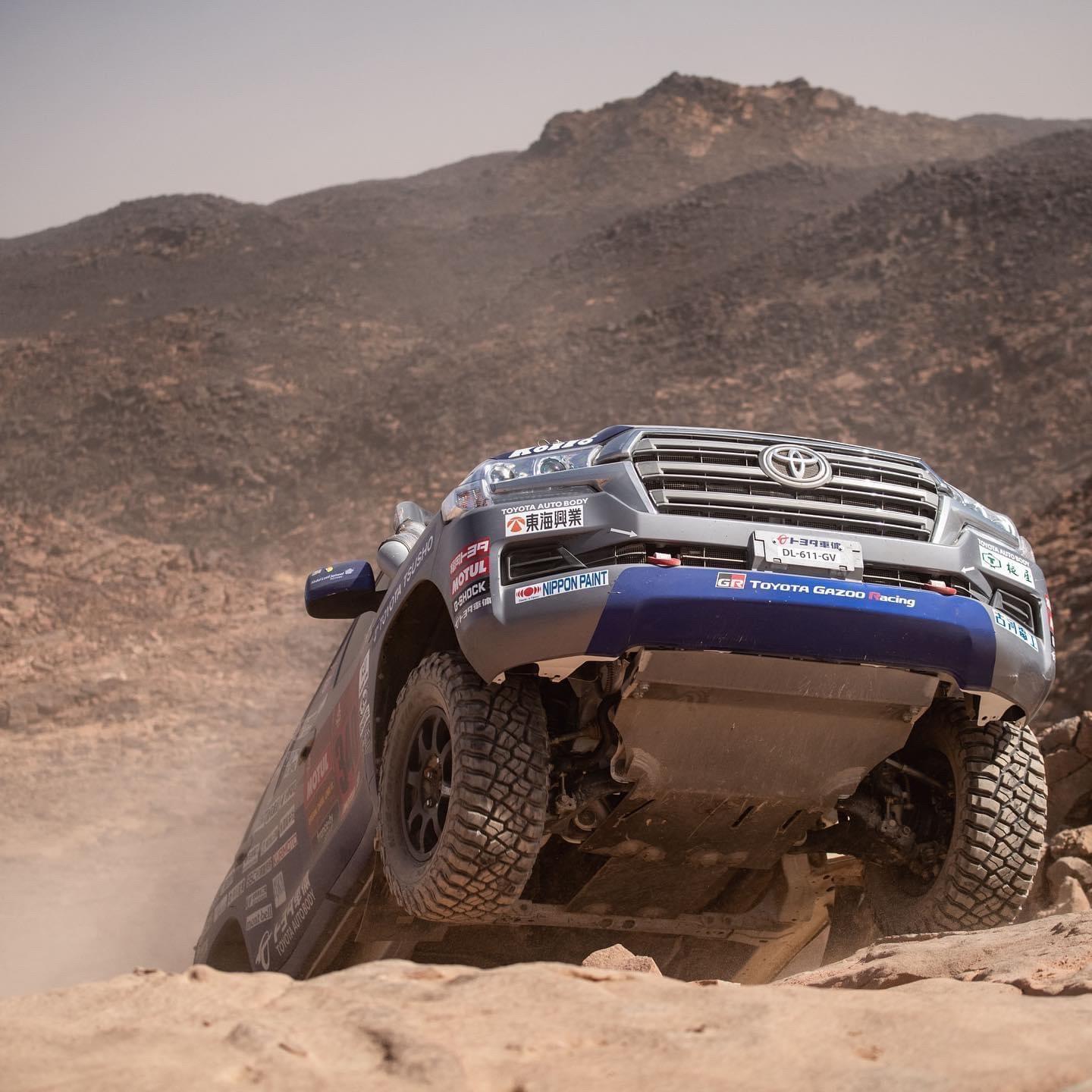
In that sense, I was happy if the vehicle was pleased, and I felt, at least in a small way, that what I did might have been a repayment. I think the Land Cruiser moved very lively.
Toyota Times:
As an employee of a company that makes the Land Cruiser, do you have any feelings for the Land Cruiser?
Miura:
I think the Land Cruiser is necessary as a daily necessity and lifeline. But not only that, the Land Cruiser gives you fun, and it gives you excitement even on difficult roads. I felt that I wanted to convey that feeling to our customers.
Taking Up the Dakar Rally Challenge as a Company Employee
Toyota Times:
Do you have any feelings about participating in the Dakar Rally as a company employee?
The more I do it, the more I think that it’s amazing to let employees do this kind of thing. It has been a lot harder than I had thought, but I’ve learned a lot about what is required. It’s great that I get to do this, and I’m grateful.
For that, when I think about what I can do, I have come to think that it is important to faithfully convey the joys and hardships I felt while driving and to be united in feelings with the people who make the Land Cruiser.
I think that I will have paid back the Land Cruiser only when I can do that and create something that will lead to the making of “ever-better Land Cruisers”, which is what the company is aiming for.
Nakatake:
I was happy to have this valuable experience, but, at first, I was surprised. I hope to apply what I have learned in the company, and there were many things that helped me grow as a person.
The way I look at the work I usually do has changed and I’m noticing more things. So, I think that there are many aspects (of participating in the Dakar Rally) that can be put to good use in my work. The same applies to training my juniors, and many people are aiming to participate in the Dakar Rally, so I would like to support them.
Miura:
I would like you to understand that I’m not just talking about people at Toyota Auto Body and Fukuoka Toyota, but about everyone involved in the Land Cruiser. In the past two or three years, I have had more opportunities to work with people involved in Land Cruiser development at Toyota almost daily.
At such times, I keenly feel that everyone loves the Land Cruiser.
I strongly want users and people who don’t know the Land Cruiser to know that it is made by people who like it that much.
Because a driver is exposed to various places, a driver is in a position to put out the word, so I would like to be able to convey that as well.
What Morizo Means to Team Land Cruiser
Toyota Times:
President Toyoda, or, more precisely, Morizo is also a person who really likes cars. You drove together with Morizo in Morocco three years ago. Do you have any thoughts about him?
Miura:
Until just before we met in Morocco, I thought that it would be “President Toyoda” who was coming. So, I was very nervous and thought I had better not mess up.
However, within 30 seconds of riding in the Land Cruiser, I felt that he was probably in the car with the same tension as me, and I was honestly very happy.
My honest impression was that I was truly happy to have a boss who liked cars so much and truly happy to be involved in the work of making cars. So, I became of Morizo fan.
Once I knew that he really liked cars, I was happy, and I think that I had a fun time driving.
I guess that the French members of our team were really happy about that, too. I think Morizo’s way definitely came through to them. That’s because Chief Mechanic Fifi (Philippe Challoy) would always happily say: “The boss really likes rallies and he likes cars.”
That really makes one happy. We race in real races. Morizo supports us. Or, I should say, he comes because he likes it. We are happy, honestly.
Another Repayment: Joined by a Mechanic on the Podium
Toyota Times:
By the way, not only the drivers and navigators but one foreign mechanic went up on the podium this year, right?
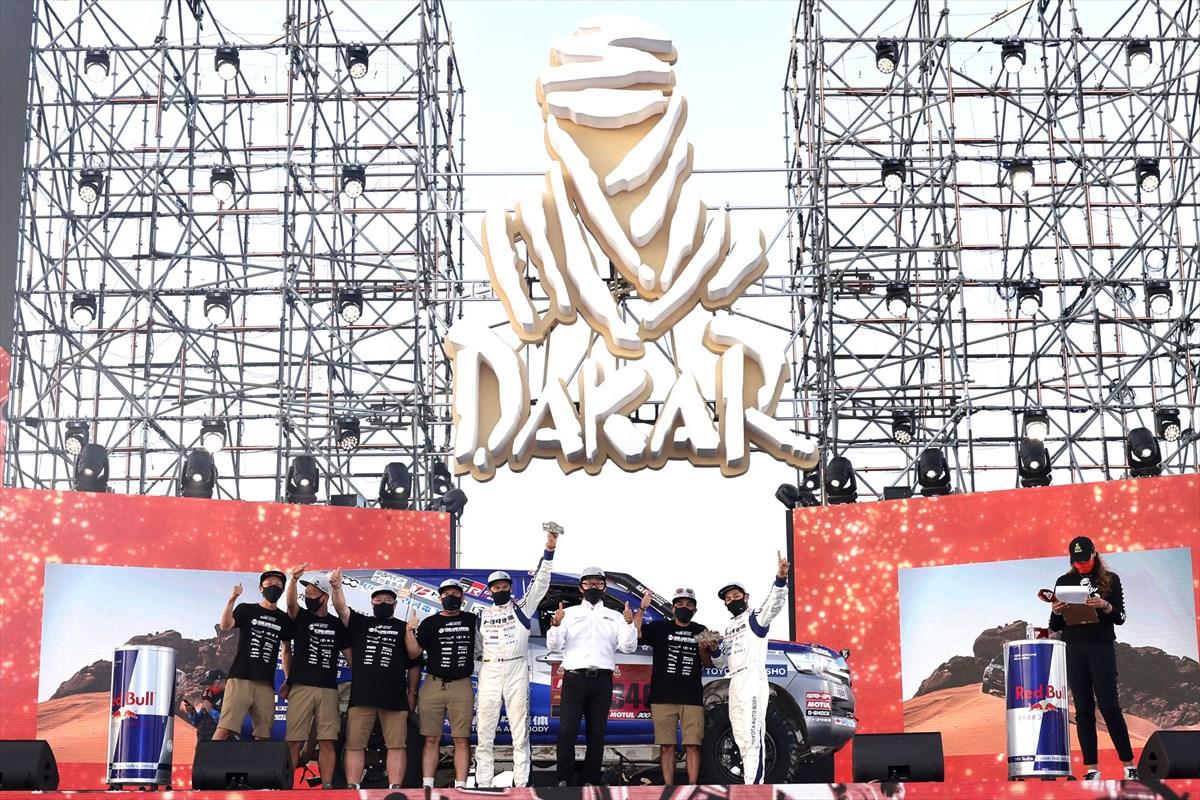
Miura:
That was Pedro (Ambrosio), who served as the lead mechanic of our car No. 340, and he’s Nakatake’s boss under our current system.
In our team, it’s not decided which mechanic will be assigned to which vehicle every year, but ever since I was a navigator, Pedro has often been the lead mechanic for my vehicle.
After becoming a driver, I was still not very good compared to the professional French drivers, so I often damaged my vehicle, giving Pedro a lot of trouble, and finishing in second place more often than winning.
Because we were competing together, I was feeling: “I couldn’t win again this year. Sorry.” But Pedro always said to me: “It's great to be able to finish with two cars! Way to go! Congratulations!”
Even after coming back with a damaged vehicle, he would say: “As long as you make it back, we can find a way. Don’t worry about anything and get some sleep.” What a cool guy.
However, when thinking about his feelings, as long as he is competing, I think he definitely has a desire to win.
In that sense, I wanted Pedro, who had worked with me, to feel that we had won together.
That's why I urged him to come with me, saying: “Let's get grab that trophy together on the podium!”
However, Pedro, right before going up, started to get nervous, asking: “Is it really okay?”. I had to halfway force him up, but I was relieved to hear him tell me at breakfast this morning: “Thank you!”
He really saved me time and time again.
Toward 12 Consecutive Wins
Toyota Times:
And finally… While you won eight, you still have to win four more under the “V12” mission handed you by big boss Morizo. (Laughs.) Although you just finished a grueling battle, please share with me your thoughts on 12 wins!
Miura:
The word “V12” has been uttered, and I want that word to be part of the history of the Land Cruiser.
Of course, winning is the team’s goal every year, but things don’t always go perfect in the Dakar Rally.
No matter how much you prepare, how much you plan, no matter how good the conditions are, completely unexpected things will happen. However, overcoming them should surely lead to honing the Land Cruiser.
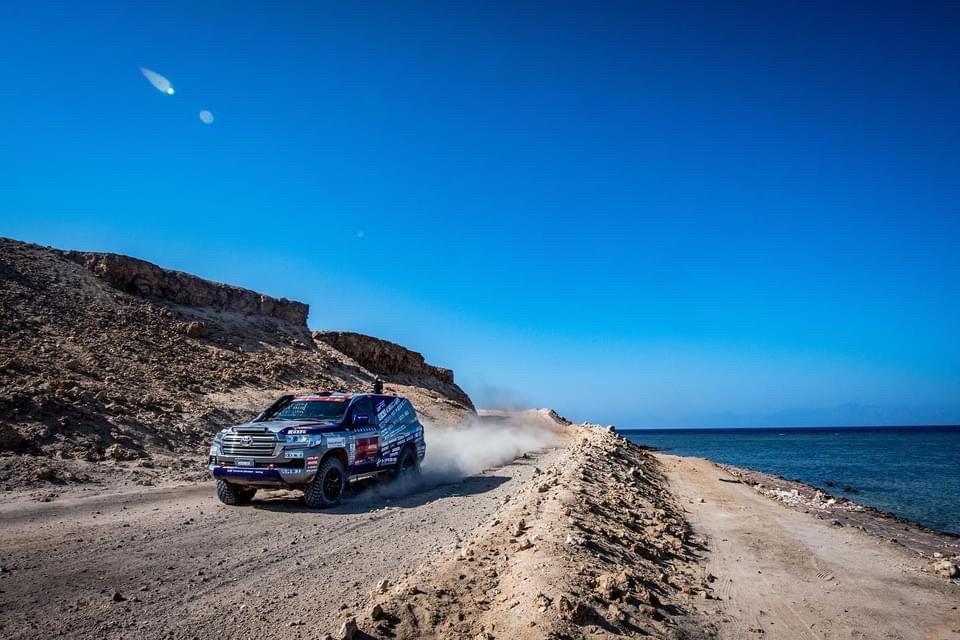
If you don’t aim to keep on winning, I don’t think you can get any clues or feedback from nature’s severe conditions.
In that sense, I want 12 wins to be part of (the Land Cruiser’s history), and I've had the opportunity to be involved in part of that long history, so I think I'd be very happy to be one of the gears that make the Land Cruiser.
Thus, because I would be happy if customers who use the Land Cruiser are able to create a memory that defines the Land Cruiser as being the only car for them and if they are able to enjoy a happy vehicle experience, I would like people to know about the Land Cruiser and give it a try.
From the Toyota Group, Hino Motors also participates in the Dakar Rally with a Hino Ranger truck. In the truck class, Hino won the title this year, which marked its 12th successive win.
The simple story is that Akio got confused by this achievement, and mistakenly referred to 12 wins when congratulating Miura.
But wait, would someone like Akio who loves motorsports very much and supports Team Land Cruiser make such a mistake?
“Don’t be satisfied with eight consecutive wins!”
“Please continue to make the Land Cruiser an ever-better car!”
Akio may have intentionally referred to 12 consecutive wins, wanting to deliver such a message. Toyota Times suspects as much.

